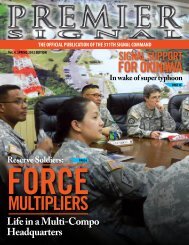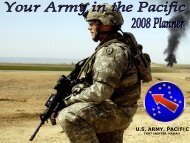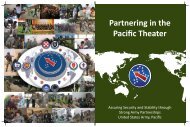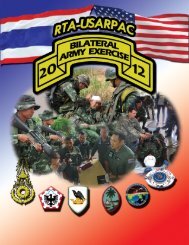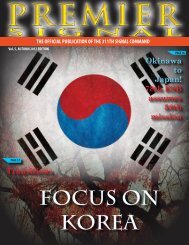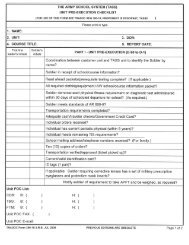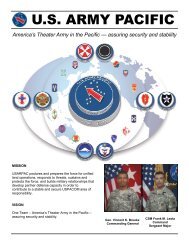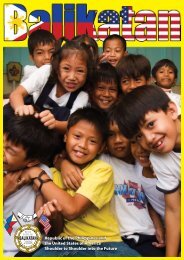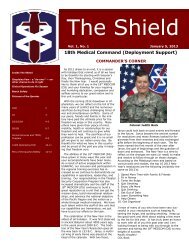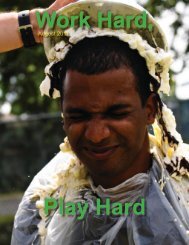COBRA GOLD - USARPAC - U.S. Army
COBRA GOLD - USARPAC - U.S. Army
COBRA GOLD - USARPAC - U.S. Army
Create successful ePaper yourself
Turn your PDF publications into a flip-book with our unique Google optimized e-Paper software.
<strong>COBRA</strong> <strong>GOLD</strong>: A LOOK AT 25 YEARS OF HISTORY<br />
Cobra Gold 2006 took place 15-25 May and marked the twenty-fifth<br />
anniversary of the exercise. Delving into US <strong>Army</strong>, Pacific (<strong>USARPAC</strong>) archival<br />
material reveals an exercise that has evolved over time to meet the changing<br />
needs of the participating countries’ militaries. While evolving into a highly<br />
sophisticated exercise, Cobra Gold remains a keystone of combined, joint<br />
military exercises conducted by the US with Association of Southeast Asian<br />
Nations (ASEAN) member states.<br />
Cobra Gold’s roots can be traced back to 1965 and Operation TEAM<br />
WORK, a naval exercise featuring combined Thai-US surface and antisubmarine<br />
operations, underwater demolition team operations, and mine<br />
warfare. Operation TEAM WORK also featured a Thai-US Marine amphibious<br />
operation as these key allies in the Vietnam conflict recognized the importance of<br />
military coordination.<br />
The first combined exercise designated as Cobra Gold occurred in 1982.<br />
In order to test all aspects of maritime operations, provide more realistic training,
and improve efficiency, the Royal Kingdom of Thailand and the US mutually<br />
agreed to combine several naval exercises into one – Cobra Gold.<br />
That first Cobra Gold in 1982 witnessed four armed forces service<br />
branches, two from each nation – the Royal Thai Navy and Air Force, along with<br />
the US Navy and Marine Corps – serving together. Two years later, the US<br />
<strong>Army</strong> first participated in the exercise. So important has the <strong>Army</strong>’s role become<br />
that since 1990, the role of exercise Executive Agent has alternated between<br />
<strong>USARPAC</strong> and US Marine Forces, Pacific (MARFORPAC) Headquarters.<br />
<strong>USARPAC</strong> was the Executive Agent for Cobra Gold 2006.<br />
In 1994, Singapore and other ASEAN countries, along with Australia,<br />
accepted Thailand’s invitation to attend Cobra Gold and sent contingents of<br />
officers to observe the exercise. Since that year, additional military observers<br />
from a host of nations have attended the exercise.<br />
In Cobra Gold 2000, uniformed Singaporeans joined forces with Thai and<br />
US service members, as Singapore became the third nation to participate in<br />
Cobra Gold instead of merely observing. Two additional countries – the<br />
Philippines and Mongolia – followed suit and have also participated in Cobra<br />
Gold beginning in 2004. That year there were over 18,000 total participants.<br />
In addition to providing an excellent training opportunity, Cobra Gold has<br />
proved an invaluable testing ground for the fielding of new weaponry or battlefield<br />
tactics as well as the impact of regional politics on a military exercise. For<br />
example, during the cross-training phase of the 1989 exercise, cavalry soldiers<br />
from the US 25th Infantry Division (Light) (25th ID(L)) gained an appreciation for<br />
2
potential regional adversaries by learning and practicing communist tactics and<br />
patrolling techniques.<br />
Another example took place the following year when soldiers successfully<br />
field tested for the Department of the <strong>Army</strong> an unmanned aerial vehicle (UAV).<br />
This six-foot long piece of equipment had a nine-foot wing span and flew<br />
distances up to three miles from the operator at an altitude of 400 to 500 feet<br />
while transmitting and recording 8mm black and white video images.<br />
SSG Paul Smith, an innovative thinker then assigned to 25ID(L)’s<br />
Headquarters, opted to manually launch the UAV while standing, braced in the<br />
open bed of a Humvee traveling at 22 miles per hour. Smith devised this<br />
unorthodox approach after discovering that launching the aircraft in the<br />
prescribed manner of running, then throwing it into the wind often resulted in the<br />
UAV’s nose dive and crash, especially if there was not wind. He noted that<br />
during the recent 25ID(L)’s exercise Team Spirit UAV field testing in Korea,<br />
airspace limitations and winds above 25 knots prevented any successful launch.<br />
3
Employing Smith’s technique, soldiers launched the UAV successfully at least<br />
eight times during the early segment of Cobra Gold 1990.<br />
As for the impact of regional politics on a military exercise, the perfect<br />
example came in 1991 when Royal Thai Supreme Commander General<br />
Sunthorn Kongsompong, Royal Thai <strong>Army</strong> Commander in Chief General<br />
Suchinda Kraprayoon, and their followers staged a coup d’etat of the ruling Thai<br />
government in February. US State Department approval to continue with the<br />
exercise resumed the following year with full participation. The military junta in<br />
Bangkok was ousted.<br />
4
]<br />
From 1992-2004, Cobra Gold became more complex and involved more<br />
nations. While such previous Cobra Gold exercises focused on countering<br />
regional aggression, Cobra Gold 2005 captured lessons learned from<br />
humanitarian actions and extensive disaster relief operations which followed the<br />
December 26, 2004, Indian Ocean earthquake and tsunami. Senior exercise<br />
leadership converted Cobra Gold’s CPX into a multinational interagency disaster<br />
relief workshop followed by a combined support force-structured Staff Exercise.<br />
Cobra Gold 2005 participants conducted humanitarian and civil assistance<br />
projects throughout the tsunami-devastated region. The disaster relief effort was<br />
an intricate operation and involved more than 100 different military,<br />
governmental, non-governmental, and private relief organizations.<br />
5
The exercise concept for Cobra Gold 2006 featured a multi-layered<br />
design. A combined task force composed of US, Thai, Singaporean, and<br />
Japanese trained together during the CPX as a United Nations peace<br />
enforcement operation (PEO) and transitioned to a peacekeeping operation<br />
(PKO). In its first twenty-five years, Cobra Gold proved to be an increasingly<br />
complex and successful exercise from which the growing number of participants<br />
learned many valuable lessons. Given this history, there is little reason to doubt<br />
that Cobra Gold will continue well into the future.<br />
6




